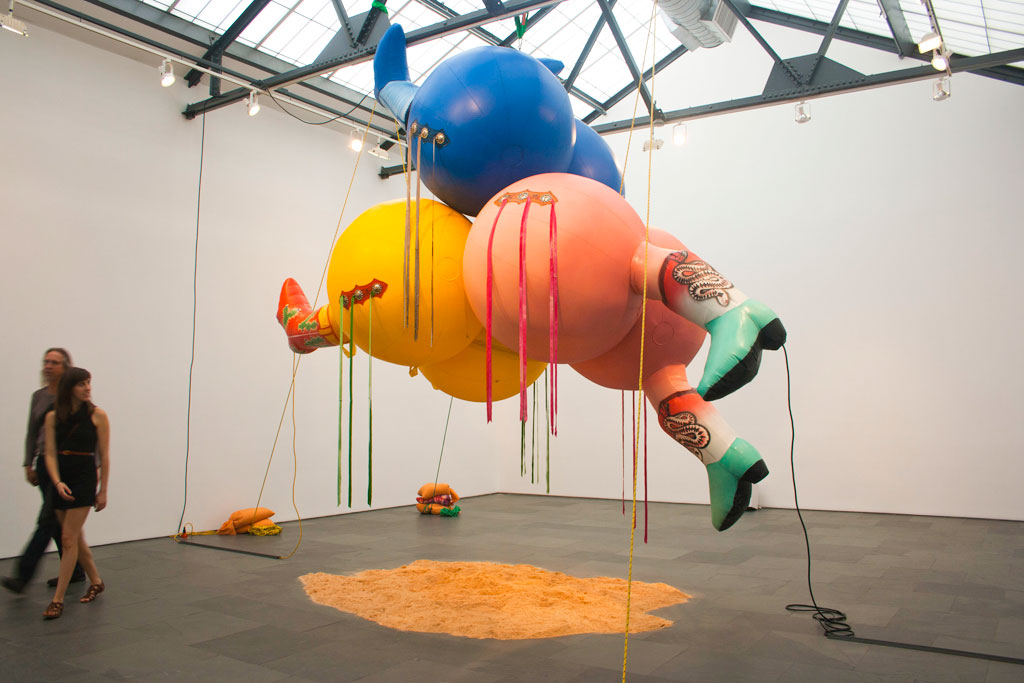Nancy Davidson: When Deep Research Is Needed to Make Sculpture

Cowboy Dustup by Nancy Davidson at Betty Cuningham Gallery, 2012.
As Creative Capital celebrates its 20th anniversary, we are looking back at some of the 561 projects supported over the past two decades—including film, visual art, performance, literature, technology, social practice, and everything in between. In each piece, artists reflect on their projects and their insights, struggles, accomplishments, and how Creative Capital helped shape their practice.
Nancy Davidson watched the twin towers fall from her studio on September 11, 2001. In the political activity that followed, she became devastated by what the US was turning into and started reflecting on her past experience with characters that inspired her as a child. “It wasn’t usual for me to do that,” she said. She turned to the rhinestone cowgirl: “Doris Day, the legend of the cowgirl, and the American West really inspired me as a girl. It had so little to do with me as a child in Chicago.” With this idea, she applied for a Creative Capital Award to create a series of sculptures called Cowgirl Dustup. In 2005, she received the award to make the work.
Davidson said that when she received the Creative Capital Award, “I realized I was so far from actually coming up with a piece and a clear idea.” She used the funding to begin a long journey of research, starting in Texas at the National Cowgirl Museum. The museum suggested Davidson check out the rodeo next door. “It turned out to be the Women’s National Finals,” she said, and “the woman that I became obsessed with was riding her last ride after a 47-year career. She was 62 years old, and she was riding rough stock, meaning she was riding bucking broncos and bulls. I couldn’t believe it. That was the person and the experience that informed my whole project.”
The Creative Capital Award turned out to be crucial for Davidson’s project, allowing her the funding and support to do deep research that she wasn’t able to do before. “I have worked full time at SUNY Purchase for years. I can fund my projects in many ways,” she said, “but the whole research aspect was something I could never have done without Creative Capital’s support.” Davidson threw herself into the research, attending rodeos across Texas, becoming engrossed in Western novels and movies, and even going to a Western music conference in Albuquerque.

Inspired by how power is communicated through minimalist sculpture in works by Donald Judd and others, Davidson looks to insert an irreverent, critical, and ultimately feminist message through her sculpture. Thinking about the turbulent political times we find ourselves in, Davidson suggested that we are in a liminal era—one that might make more sense looking back ten years from now. “Everything is changing and we can’t step out of it yet,” she said. Offering a counterpoint to this volatility, Cowgirl Dustup—which premiered at Betty Cunningham Gallery in 2012—”takes on popular culture, and questions the whole idea of the spectacle,” asking what if the spectacle centered around an American pop icon, like the cowgirl?
Recently, Aruna Da Souza noticed that Lizzo’s set design looked similar to work by Davidson. Even though Lizzo’s set designer swore she hadn’t seen Davidson’s work before, the comparison between Lizzo and Davidson’s sculptures made sense: Lizzo’s message of feminine positivity, self-love, and glamour rhymed with Davidson’s work. “A large butt in American culture is called the moment,” Davidson suggested.
As she works on a solo exhibition at Krannert Museum in Illinois opening in January 2020, Davidson continues to think about “why I need to push my work beyond just the visual gaze.” Working in collaboration with composer and performer Lakshmi Ramgopal, Davidson will present a contemporary parody of the hybrid goddess, and maiden in the exhibition, Hive. As always in her work, humor and satire will help visual forms depict role models that can act as anchors in these turbulent times.
